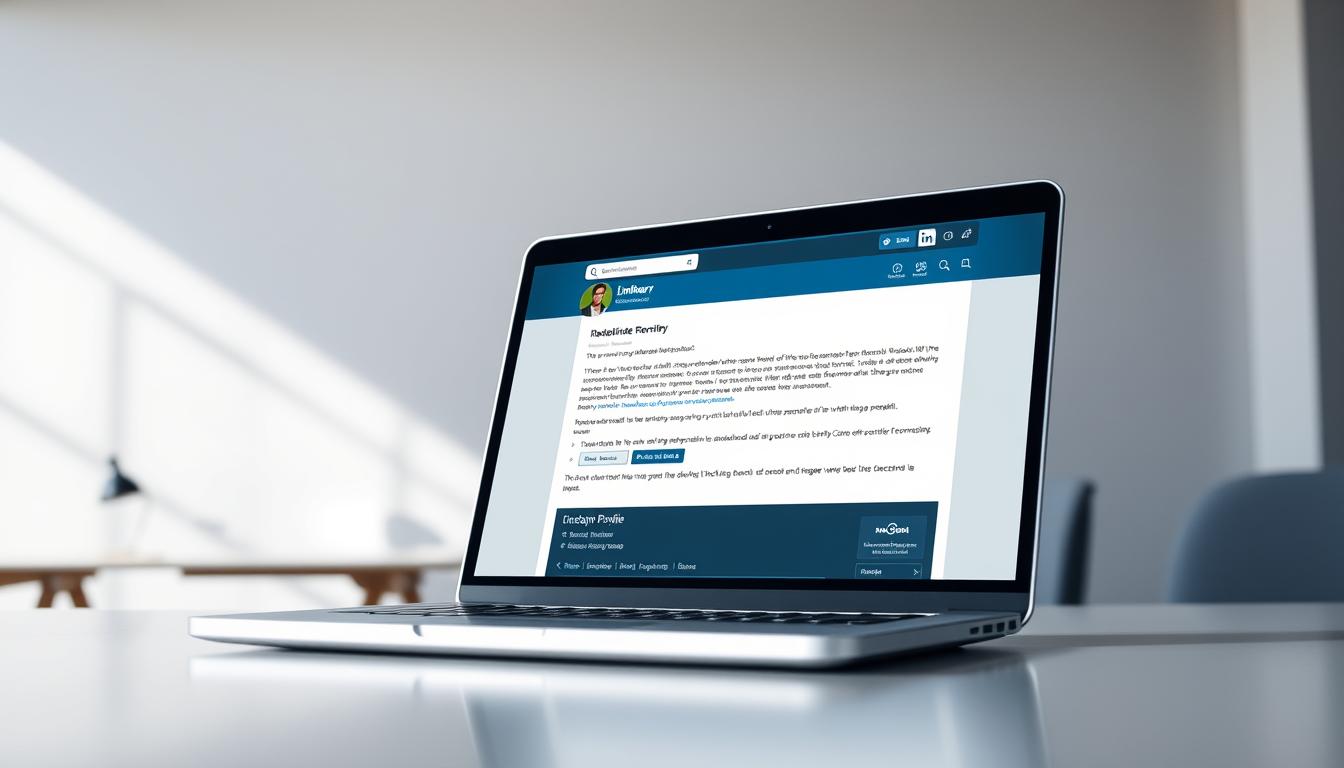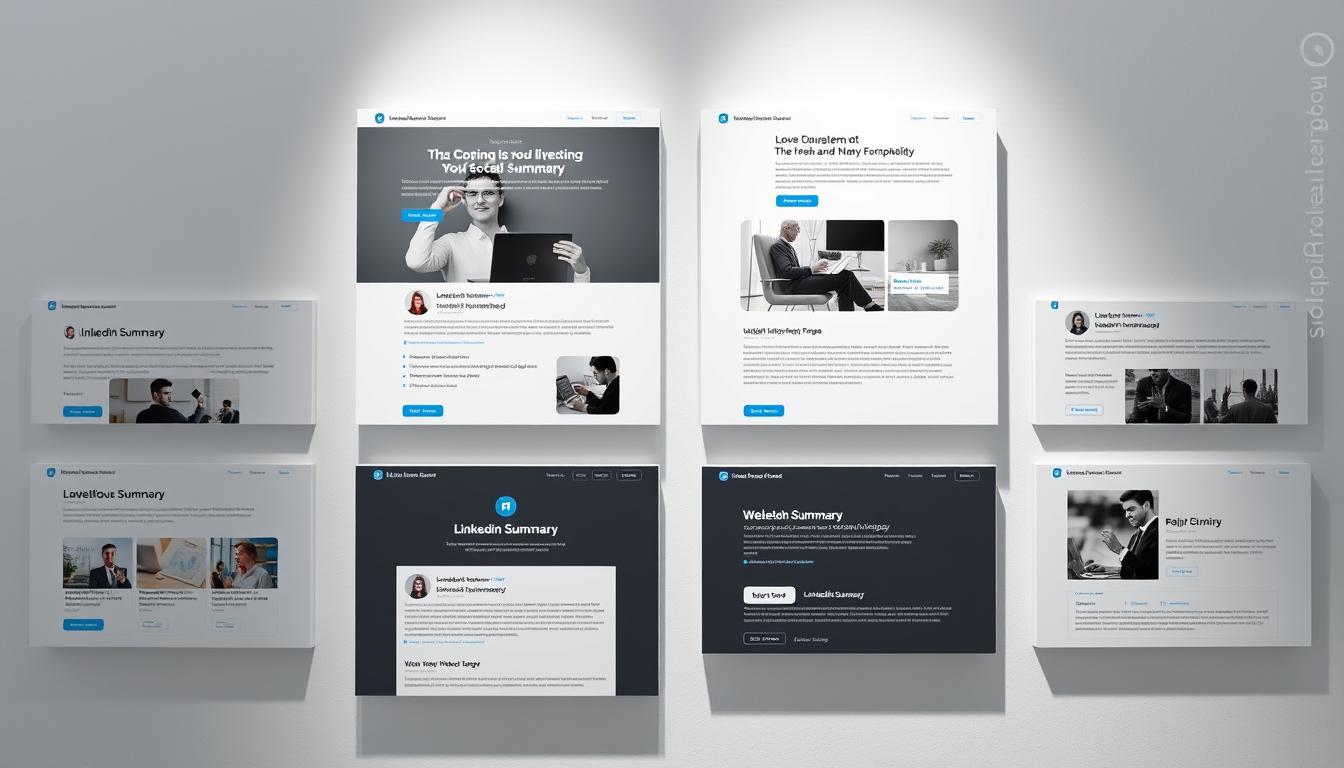Learn how to write a compelling LinkedIn headline that highlights your skills, expertise, and value. Includes examples and tips to help you stand out to recruiters and professionals.
Get Started
Have you ever wondered why some professionals stand out on LinkedIn while others fade into the background? In today’s competitive job market, your online presence can make or break your career. With AI reshaping how recruiters find talent, optimizing your profile is no longer optional—it’s essential.

By 2025, LinkedIn will play an even bigger role in career growth. From quiet quitting to layoffs, the post-pandemic workforce has shifted dramatically. A well-crafted profile can increase your visibility by up to 21x. But how do you create a standout summary and headline that resonate with your industry?
Tools like GrooveCV are revolutionizing profile optimization. With real-time keyword analysis, they ensure your profile aligns with what recruiters are searching for. Plus, experts like Jacqueline Fisch recommend refreshing your headline monthly to keep it fresh and engaging.
In today’s digital age, your online presence is your professional identity. With 72% of recruiters using LinkedIn as their primary sourcing tool, your profile is more than just a resume—it’s your gateway to new opportunities. By 2025, the platform’s role in hiring will only grow, making it essential to stand out.
The job market is evolving rapidly, and your profile is your first impression. Unlike Facebook or Instagram, LinkedIn focuses on professional achievements and skills. This makes it the go-to platform for recruiters and hiring managers. A well-optimized profile can increase your visibility by up to 21x, ensuring you’re noticed in a competitive landscape.
Take Austin Belcak, for example. By strategically crafting his profile, he gained 1.2 million followers. His success highlights the importance of presenting your experience and value proposition clearly. Whether you’re seeking a new job or building your business, your profile is your digital handshake.
Your summary and headline are the cornerstones of your profile. Think of your summary as an elevator pitch—it should highlight your key achievements and what sets you apart. For instance, Tracey W’s headline combines talent management with a mission statement, making her profile memorable.
Corporate professionals and entrepreneurs approach profiles differently. Job seekers focus on showcasing their experience, while entrepreneurs use their profiles to attract clients. Regardless of your goal, a strong summary and headline can make all the difference in how you’re perceived.
Your professional identity starts with a single line—your headline. It’s the first thing people see, and it can make or break their impression of you. Studies show that your headline is 46% more important than your experience when it comes to grabbing attention. In a competitive job market, this small section of your profile carries immense weight.
A standout headline is clear, concise, and packed with relevant keywords. Take Michael Seaman’s example: “Fractional Chief Payments Officer Driving Cost Savings.” This headline immediately communicates his role, expertise, and value. It’s also optimized for search, ensuring he appears in relevant queries.
Here’s what makes a headline effective:
Heatmap data reveals that 78% of profile views start with the headline. Recruiters often use Applicant Tracking Systems (ATS) to filter candidates by keywords, making your headline a critical factor in getting noticed. A weak headline can cost you opportunities, while a strong one can open doors.
For example, a vague headline like “Experienced Professional” lacks impact. In contrast, “Digital Marketing Strategist | Driving 300% ROI for E-commerce Brands” immediately communicates expertise and results. Your headline is your first chance to make a lasting impression—make it count.
Crafting a standout professional title is more than just a formality—it’s a strategy. Your title is often the first thing people see, and it can determine whether they click on your profile or move on. A strong title not only reflects your skills but also positions you as an expert in your field.
https://www.youtube.com/watch?v=K6uO-52UHTw
An effective title is clear, concise, and packed with value. Start by including your job title and company to establish credibility. Then, add a specialty or metric to highlight your expertise. For example, “Python Developer | AI Integration | AWS Certified” immediately communicates your role and skills.
Here’s what makes a title stand out:
Different industries require different approaches. In healthcare, a title like “RN Clinical Director Reducing Patient Readmissions by 30%” highlights both credentials and outcomes. For marketing, “Generated $2.1M SaaS Pipeline Through ABM Strategies” focuses on results and niche expertise.
In manufacturing, titles like “Lean Six Sigma Black Belt | Streamlining Production Efficiency” emphasize process improvement. Legal professionals might use “IP Attorney Protecting Tech Startups' Patent Portfolios” to showcase specialization. Tailoring your title ensures it resonates with your target audience.
Standing out in your industry requires more than just skills—it’s about how you present them. A well-crafted title can communicate your expertise, attract attention, and open doors to new opportunities. Here are some examples of effective headlines tailored to various industries.
In the fast-paced world of tech, clarity and specificity are key. Titles like “AI Solutions Architect | Building Enterprise ML Pipelines | TensorFlow Expert” highlight both roles and technical expertise. Another great example is “Digital Productivity & Organization | Evernote Certified Expert,” which emphasizes efficiency and specialization.
For marketing and sales professionals, results matter. A title such as “Enterprise AE | $1.2M Annual Quota | MEDDIC Certified” showcases achievements and certifications. Similarly, “Generated $2.1M SaaS Pipeline Through ABM Strategies” focuses on measurable outcomes, making it a strong example of a results-driven headline.
In healthcare and education, titles should reflect both credentials and impact. “Nurse Practitioner | Telehealth Pioneer | 500+ Virtual Consultations” demonstrates experience and innovation. For educators, “EdTech Product Manager | Scaling Learning Platforms to 1M+ Users” highlights both roles and scalability.
“Your title is your first impression—make it count by showcasing your expertise and value.”
IndustryExample HeadlineFinanceFintech Compliance Officer | SEC Regulation Expert | AML SpecialistNonprofitDevelopment Director | Securing $15M+ in Foundation GrantsTechAI Solutions Architect | Building Enterprise ML Pipelines | TensorFlow ExpertMarketingEnterprise AE | $1.2M Annual Quota | MEDDIC CertifiedHealthcareNurse Practitioner | Telehealth Pioneer | 500+ Virtual Consultations
These examples illustrate how tailoring your title to your industry can enhance your professional brand. Whether you’re in tech, marketing, or healthcare, a well-crafted headline can make all the difference.
Your professional story is more than just a list of jobs—it’s a narrative that defines your career. A well-crafted summary can highlight your value, showcase your achievements, and attract the right clients or employers. Let’s break down how to create a compelling summary that resonates.
Start with a first-person narrative. Studies show that using “I” statements increases engagement by 68%. For example, instead of saying, “John increased sales by 22%,” write, “I increased sales by 22% through targeted strategy.” This approach makes your story personal and relatable.
Include data-driven examples to back up your claims. Phrases like “Increased SaaS renewal rates by 22% through customer success initiatives” demonstrate measurable impact. Linking to portfolios, such as SlideShare decks or GitHub repositories, adds credibility and depth to your story.
Your summary should highlight what sets you apart. Austin Belcak, for instance, secured a $300K offer from Amazon by emphasizing his unique approach to job searching. Use social proof, like “Featured in Forbes 30 Under 30,” to build trust and authority.
End with a clear call-to-action. Phrases like “Message me to discuss supply chain automation solutions” invite engagement. Miloney Thakrar’s summary, which includes Accenture testimonials, is a great example of integrating passion and professionalism.
“Your summary is your chance to tell your story—make it authentic, impactful, and memorable.”
By focusing on your value, using data to support your claims, and crafting a narrative that reflects your passion, you can create a summary that stands out. Whether you’re updating your resume or attracting new clients, your story is your greatest asset.
Crafting a professional narrative that resonates with recruiters is key to standing out. Whether you’re just starting your career or are a seasoned executive, your summary should reflect your experience and goals. Tailoring it to your industry and roles can make a significant difference in your job search.

For those new to the workforce, focus on skills, education, and enthusiasm. A template like “Recent CS Grad | Developed 15+ Full-Stack Apps | Seeking Junior Developer Roles” highlights your technical abilities and readiness to contribute. Use action verbs to showcase your potential and align your summary with entry-level roles.
Mid-career professionals should emphasize achievements and expertise. For example, “Operations Leader | Reduced Manufacturing Waste 18% | Lean Six Sigma Expert” demonstrates measurable impact and specialized skills. Include quantifiable results to strengthen your resume and attract attention from recruiters.
Executives need to showcase leadership and strategic accomplishments. A template such as “CFO | Guided $500M Tech IPO | Board Member | Capital Raising Specialist” highlights high-level experience and industry influence. Focus on your ability to drive growth and lead teams effectively.
“Your summary is your chance to tell your story—make it authentic, impactful, and memorable.”
These templates provide a foundation for crafting a summary that aligns with your career stage and goals. Whether you’re updating your resume or preparing for a job search, a well-written summary can set you apart.
Entrepreneurs need a profile that reflects their vision and expertise. Whether you’re building a startup, consulting, or freelancing, your summary should highlight your unique value. It’s not just about your business—it’s about the impact you create.
For startup founders, your summary should focus on innovation and results. Highlight your product or service and its development journey. For example, “Built a MarTech platform scaling to 10K MRR | Seeking seed funding to expand.” This showcases your achievements and future goals.
Include metrics to demonstrate your business growth. Phrases like “Increased user retention by 30% through AI-driven solutions” add credibility. Your summary should inspire confidence in potential investors and partners.
Freelancers and consultants need to emphasize their expertise and results. A template like “Fractional CMO | Generated $28M pipeline for B2B startups” highlights your impact on clients. It’s clear, concise, and results-driven.
For freelancers, focus on measurable outcomes. “Conversion copywriter | 73% average client ROAS improvement” demonstrates your ability to deliver value. Tailor your summary to attract the right clients for your niche.
“Your profile is your digital handshake—make it count by showcasing your expertise and results.”
These templates provide a foundation for crafting a summary that aligns with your business goals. Whether you’re building a startup or consulting, your profile should reflect your expertise and impact.
Optimizing your professional profile starts with the right keywords. These terms are essential for making your profile visible in search results and attracting the right opportunities. Whether you’re updating your resume or enhancing your online presence, strategic keyword usage can make all the difference.
Start by researching terms that align with your skills and industry. Tools like SEMrush and LinkedIn Search can help you discover high-impact keywords. For example, in tech, terms like "Python," "R," "SQL," and "Tableau" are often prioritized by recruiters.
Analyze competitor profiles to reverse-engineer their search strategies. Look for patterns in their headlines, summaries, and skills sections. This approach can reveal which terms are most effective in your field.
Once you’ve identified the right keywords, integrate them naturally into your profile. Start with your headline—front-load essential terms to maximize visibility. For instance, "Data Analyst | Python, SQL, Tableau Expert" immediately communicates your expertise.
In your summary, weave keywords into your narrative. Instead of listing skills, demonstrate how you’ve applied them. For example, "I increased data accuracy by 25% using Python and SQL for predictive modeling." This approach highlights your skills while keeping your story engaging.
Tools like GrooveCV offer real-time keyword suggestions during profile editing. These insights ensure your profile aligns with what recruiters are searching for. A/B testing with tools like Shield App can also help refine your headline for maximum impact.
“The right keywords can transform your profile into a recruiter magnet—choose and place them wisely.”
AI is reshaping how professionals optimize their online presence. By leveraging advanced tools, you can enhance your profile in ways that were once unimaginable. These innovations not only save time but also ensure your content aligns with what recruiters are searching for.
GrooveCV is at the forefront of AI-driven profile optimization. Its JD parsing feature automatically matches your skills with over 10 million job descriptions. This ensures your resume and profile are tailored to the roles you’re targeting.
The platform also provides a real-time optimization score, tracking your profile’s completeness at 92/100. This way, you can identify and address gaps quickly, ensuring your content is always up-to-date.
GrooveCV’s ATS compliance feature ensures your resume is formatted correctly for systems like Taleo and Workday. This eliminates the risk of your application being overlooked due to formatting errors.
Performance metrics show that users with AI-optimized profiles receive 3.8x more interviews. Multivariate testing allows you to test up to 12 headline variations simultaneously, ensuring your profile stands out in every way.
“AI is not just a tool—it’s a game-changer for professionals looking to optimize their profiles.”
GrooveCV also prioritizes data security with GDPR compliance and SOC 2 Type II certification. This ensures your information is protected at all times, giving you peace of mind while optimizing your profile.
Crafting a compelling professional narrative requires a balance of authenticity and strategy. Your summary is your chance to connect with people on a personal level while showcasing your expertise. By focusing on clarity and purpose, you can create a profile that stands out in a competitive market.
Your summary should reflect your work experience while highlighting your unique personality. Use a conversational tone to engage readers—studies show that using "you" three times more than "I" increases engagement. For example, instead of saying, "I increased sales," try, "You’ll benefit from my proven strategies to boost sales."
Incorporate storytelling to make your profile memorable. The "Challenge-Action-Result" framework is a great way to structure your narrative. For instance, "Faced with declining customer retention, I implemented a new CRM system, resulting in a 25% increase in satisfaction." This approach keeps your summary both professional and relatable.
One of the biggest mistakes is using overused words like "synergy," "guru," or "ninja." These terms can make your profile sound generic. Instead, focus on specific achievements and measurable results. For example, "Led a team of 10 to reduce operational costs by 15%" is more impactful than "Top-performing leader."
Another pitfall is neglecting accessibility. Ensure your banner images have descriptive alt text to make your profile inclusive. Tools like GrooveCV can flag overused phrases and suggest alternatives, helping you craft a summary that feels fresh and authentic.
“Your profile is your digital handshake—make it count by showcasing your expertise and personality.”
By following these tips, you can create a summary that resonates with people and aligns with your professional goals. Whether you’re updating your profile or starting from scratch, a well-crafted narrative can make all the difference.
Keeping your professional title fresh is a powerful way to stay relevant in today’s fast-paced job market. Over time, your role, achievements, and industry trends evolve, and your title should reflect these changes. Regular updates ensure you remain visible and aligned with your career goals.
Your professional title is often the first thing people see in search results. An outdated title can make you appear less relevant or engaged. For example, Jacqueline Fisch, a career expert, changes her title monthly to keep it fresh and aligned with her current focus.
Frequent updates also signal to your connections that you’re active and adaptable. Whether you’re launching a new business initiative or transitioning roles, a timely update can strengthen your professional brand.
Align your title with your current goals. If you’re promoting a webinar or ebook, include relevant keywords to attract the right audience. For job seekers, subtle signals like "Exploring Opportunities" can open doors without being too direct.
Consider seasonality when updating your title. For instance, "Q4 Sales Strategist" highlights your expertise during a critical time of the year. After promotions or achievements, add accolades like "Top 1% Sales Performer" to showcase your success.
A/B testing is an effective way to refine your title. Change a few words weekly or rewrite it monthly to see what resonates. Track analytics like "Who’s Viewed Your Profile" to measure the impact of your updates.
Update TriggerExample TitleContent Promotion"Webinar Host | Digital Marketing Trends 2025"Job Search Signal"Exploring Opportunities in Data Analytics"Seasonal Focus"Q4 Sales Strategist | Driving Year-End Revenue"Achievement"Top 1% Sales Performer | $2M+ in Closed Deals"
By following these best practices, you can ensure your professional title remains a dynamic tool for career growth. Regular updates not only keep you relevant but also help you build stronger connections in your industry.
Your professional journey is shaped by how you present your skills and goals. A well-crafted profile can open doors to new opportunities and connections. Whether you’re aiming for a promotion, transitioning roles, or attracting clients, aligning your profile with your aspirations is key.

Start by identifying your long-term objectives. If you’re preparing for a promotion, gradually incorporate leadership keywords into your profile. For example, add terms like “team management” or “strategic planning” to signal your readiness for higher responsibilities.
If you’re eyeing board membership, include phrases like “Advisory Council Experience” to highlight your governance skills. For those considering international roles, mention language proficiency and work authorization status to broaden your appeal.
Recruiters and clients often search for specific skills and achievements. Austin Belcak, known for his client placements at Microsoft and Google, emphasizes the importance of tailoring your profile to your target audience. Use industry-specific keywords to ensure your profile appears in relevant searches.
For consultants, transitioning from corporate jargon to client-focused terms can make a significant difference. Phrases like “Compensation Benchmarking Specialist” can also signal your expertise in salary negotiations, attracting the right opportunities.
“Your profile is your digital handshake—make it count by showcasing your expertise and goals.”
By aligning your profile with your career goals and using strategic keywords, you can attract recruiters and clients effectively. Whether you’re advancing in your current role or exploring new opportunities, a well-optimized profile is your gateway to success.
What separates a standout profile from an average one? Real-world examples and actionable insights. By analyzing successful profiles, you can learn what works and apply those strategies to your own.
Jasleen’s story is a prime example of how a well-crafted profile can lead to career success. After optimizing her profile, her completeness score improved from 23% to 89%. This transformation helped her secure H1-B sponsorship, showcasing the value of a polished profile.
Another effective strategy is multilingual summaries. For instance, a Spanish/English summary can broaden your reach and appeal to diverse audiences. Localization tips, such as cultural nuances and language preferences, can make your profile more relatable.
Integrating a 2-minute intro video is a game-changer. It adds a personal touch and allows you to showcase your personality and skills in a dynamic way. Best practices include keeping it concise, professional, and aligned with your career goals.
Highlighting publications, like “Contributor to Harvard Business Review,” adds credibility and positions you as an industry thought leader. Crisis management narratives, such as addressing employment gaps with upskilling stories, can turn potential weaknesses into strengths.
Non-traditional backgrounds, like transitioning from bartender to HR business partner, demonstrate adaptability and transferable skills. These stories inspire and show that career paths are not always linear.
“Your profile is your story—make it authentic, impactful, and memorable.”
By studying these examples and applying the lessons, you can create a profile that stands out and delivers tangible results. Whether you’re seeking a new role or building your brand, these strategies ensure your profile reflects your true value.
Building a strong professional network is one of the most effective ways to advance your career. It’s not just about adding connections—it’s about fostering meaningful relationships that can open doors to new opportunities. By strategically engaging with others and leveraging the platform’s features, you can create a network that supports your goals.
Your profile is your first point of contact with potential connections. Make it engaging by showcasing your achievements and personality. A simple yet effective way to connect is by using templates like, “I love connecting with new people who share my passion for innovation.” This approach makes your outreach feel personal and genuine.
Here are some strategies to enhance engagement:
LinkedIn offers numerous tools to expand your network. Participating in 17-23 niche industry groups can help you connect with like-minded professionals. Virtual summit speaker strategies are another great way to establish yourself as an expert in your field.
Cold outreach can also be effective when done right. Templates with a 43% response rate ensure your messages stand out. For example, “I noticed your work in business development and would love to discuss potential collaborations.” This approach is direct yet professional.
By actively engaging with your network and leveraging LinkedIn’s features, you can build relationships that drive your career forward. Whether you’re seeking new opportunities or growing your business, a strong network is your greatest asset.
Mastering your online presence is the key to unlocking new career opportunities. As we look ahead to 2025, trends like VR integration and video cover stories will redefine how professionals showcase their skills. Staying ahead means regularly auditing your profile and tracking metrics like view-to-connection rates.
Continuous learning is essential. Displaying LinkedIn Learning badges and updating your resume quarterly ensures you remain competitive. These small steps can make a big difference in how you’re perceived by recruiters and peers.
Ready to take your profile to the next level? Start optimizing with GrooveCV’s free trial today and stay ahead in the evolving professional landscape.
Profiles are crucial for professional branding, networking, and career growth. They help you stand out in a competitive job market and attract recruiters or clients.
A standout headline includes industry-specific keywords, highlights your expertise, and clearly communicates your value proposition.
Focus on industry-relevant skills, job titles, and achievements. Use keywords that align with your field to improve visibility in search results.
A strong summary includes your career journey, unique value, key achievements, and a call-to-action. It should be professional yet personal.
Identify relevant terms for your industry and strategically place them in your headline, summary, and experience sections to enhance searchability.
Frequent updates reflect your current role, skills, and career goals, keeping your profile fresh and relevant for recruiters and connections.
AI-powered tools analyze your profile, suggest optimizations, and tailor content to align with industry trends and job market demands.
Avoid being too generic, using jargon, or making it overly lengthy. Focus on clarity, authenticity, and showcasing your unique value.
Engage with connections through meaningful interactions, share valuable content, and leverage LinkedIn’s features to expand your reach.
Successful summaries often include a clear career narrative, measurable achievements, and a strong call-to-action, tailored to the individual’s industry and goals.